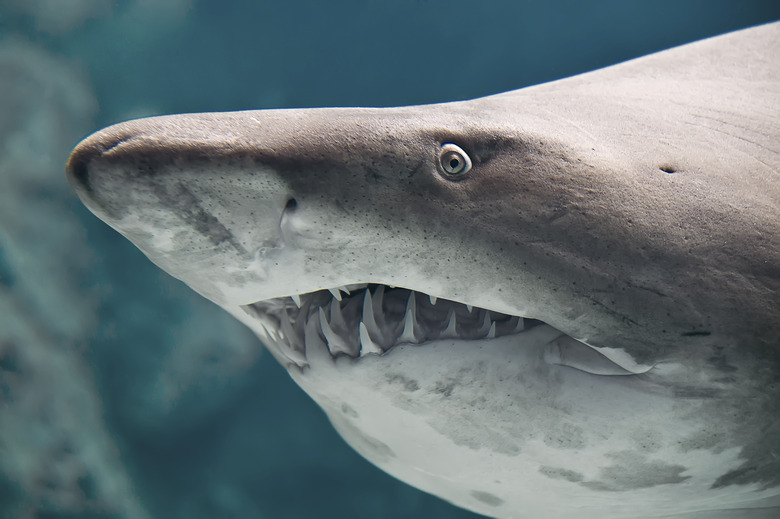What Kinds Of Sharks Are In Myrtle Beach, South Carolina?
Myrtle Beach, South Carolina, is a popular vacation destination because of its beautiful beach, white sand and great surfing. It is also a popular location for many species of sharks. South Carolina waters are home to over 40 shark species. Sharks like to reside in South Carolina waters because of the state's numerous river mouths, which sharks use as nursing and hunting grounds. Common species that frequent Myrtle Beach are spinner sharks, black tip sharks and bull sharks. These sharks are not the only species to have been sighted at Myrtle Beach, though.
TL;DR (Too Long; Didn't Read)
Myrtle Beach is home to many species of sharks, and some are frequently sighted from the beaches or coastal waters. The spinner shark is slender and about six feet long, and is not a threat to humans. The black tip shark is gray-brown and about five feet long, and rarely attacks humans, although there is greater risk if the human is in the water with a food stimulus to attract the shark. The bull shark is about ten feet long and 200 to 500 pounds, and is one of the most dangerous sharks to humans. It is an aggressive, opportunistic feeder with a large, strong jaw and a preference for very shallow waters, where humans tend to be. The tiger shark is the second-most dangerous shark to humans, after the great white shark. It is 10 to 14 feet long and 850 to 1,400 pounds. Tiger sharks are very common in South Carolina.
Spinner Shark
Spinner Shark
Spinner sharks (Carcharhinus brevipinna) have slender bodies, measuring about six feet long and weighing 120 pounds. They have a grey-bronze coloration and a white underbelly. These sharks sometimes have black tips on their pectoral fins, second dorsal fins and on the pelvic and anal fins. This shark hunts by rapidly swimming upward into a school of fish while spinning and biting in all directions. It often breaches the water surface and spins through the air, which is how it gets its name. It feeds primarily on sardines, herring, anchovies and tuna. Spinner sharks do not pose a threat to humans.
Black Tip Shark
Black Tip Shark
Black tip sharks (Carcharhinus limbatus) are grey-brown in color, measure about five feet in length and weigh around 40 pounds. Like spinner sharks, they hunt sardines, herring and anchovies. Sometimes these sharks are confused with spinner sharks because of the similar black tip color pattern on their fins. One major distinction is that the anal fin of a black tip shark does not have a black tip and is instead plain. Black tip sharks pose little threat to humans, especially without the presence of a food stimulus, such as a diver spearfishing.
Bull Shark
Bull Shark
Bull sharks (Carcharhinus leucas) range in color from pale to dark grey. They have large stocky bodies weighing between 200 and 500 pounds and measuring about 10 feet in length. These sharks' diet includes dolphins, birds, turtles, rays and other sharks. They are among the most dangerous species to humans. Reasons for this include their opportunistic feeding behavior, powerful and massive jaws, aggressive nature and a preference for shallow water, sometimes less than three feet deep. All of these factors combine to make this shark a threat to humans. Despite being both a threat to humans and common to Myrtle Beach, the last fatal shark attack to occur in South Carolina was in 2005 at Folly Beach, SC by an unidentified shark species.
Tiger Shark
Tiger Shark
In 2013, a 700 pound tiger shark (Galeocerdo cuvier) was found three miles offshore of north Myrtle Beach by fishermen. This is an aggressive shark that is second in the number of attacks on humans, trailing only the great white shark. Tiger shark sightings are not unheard of in the state of South Carolina. In fact, Port Royal Sound, South Carolina, may be home to the largest concentration of tiger sharks on the east coast. The sharks are believed to be there because of the favorable tidal conditions for hunting. The distance between Myrtle Beach and Port Royal Sound is less than 200 miles. Tiger sharks have a range that covers thousands of miles, making a visit to Myrtle Beach from Port Royal Sound relatively unremarkable.
Cite This Article
MLA
Parker, Michael. "What Kinds Of Sharks Are In Myrtle Beach, South Carolina?" sciencing.com, https://www.sciencing.com/kind-myrtle-beach-south-carolina-8177761/. 23 April 2018.
APA
Parker, Michael. (2018, April 23). What Kinds Of Sharks Are In Myrtle Beach, South Carolina?. sciencing.com. Retrieved from https://www.sciencing.com/kind-myrtle-beach-south-carolina-8177761/
Chicago
Parker, Michael. What Kinds Of Sharks Are In Myrtle Beach, South Carolina? last modified March 24, 2022. https://www.sciencing.com/kind-myrtle-beach-south-carolina-8177761/
